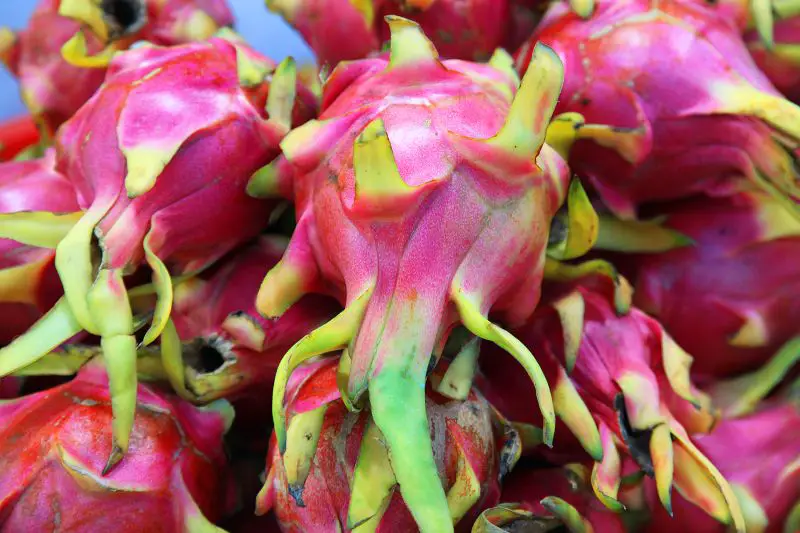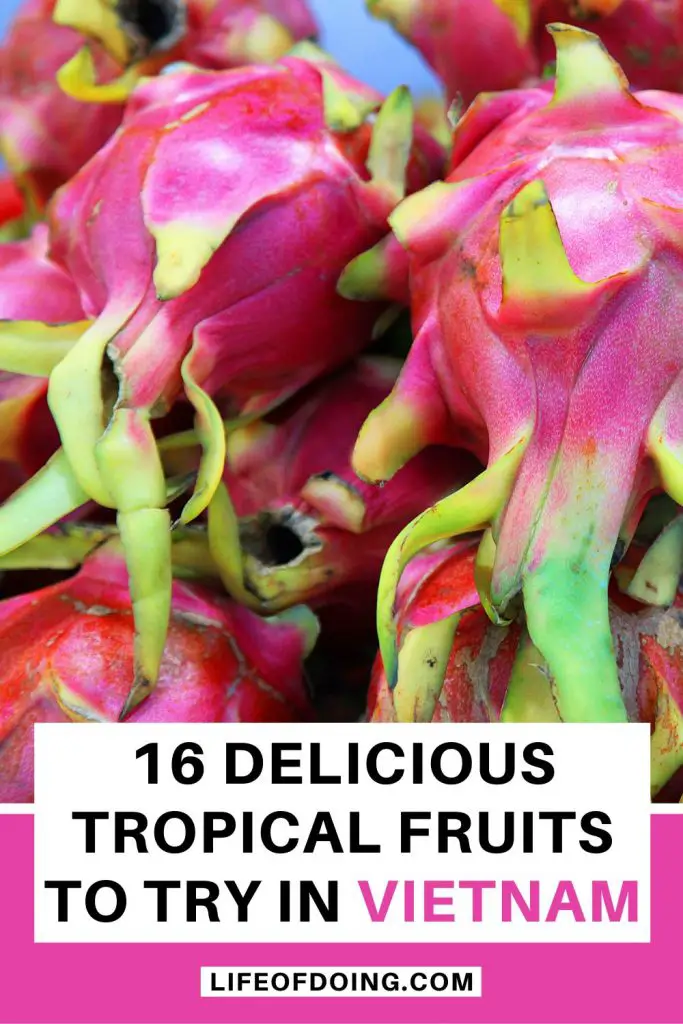What are the best tropical fruits to try in Vietnam? You’re in for a treat since there are so many delicious and fresh tropical fruits to try!
Since we’ve been living in Ho Chi Minh City for over three years, we’re spoiled with easy access to these fruits. The colorful fruits are always on display when walking through a local market, passing by a street vendor, or even at the supermarket. Plus, most are available all year round due to the consistent regional weather.
When you’re traveling through Vietnam, eating these Vietnamese grown fruits is a fantastic way to try something new and stay healthy. Plus, it’s a nice balance to your daily eating of street food and Vietnamese cuisine with incorporating antioxidants and vitamins in your diet.
Continue reading on the most unique and delicious 16 tropical fruits to eat during your Vietnam travels. We’re including helpful information such as the fruit names in Vietnamese, availability, and how to buy and eat them.
Check out our Vietnam posts to help you with your planning.
- Vietnam Travel Tips for First Time Visitors
- Travel to Vietnam on a Budget
- What to Pack for Vietnam
- Places to Visit in Vietnam
*Disclaimer: This post contains affiliate links. If you click on them and make a purchase, we receive a small commission. There is no additional cost to you. Appreciate the support.
Where Can You Find Tropical Fruits in Vietnam?
You can buy many of the fruits at the grocery store/supermarket, such as VinMart, Top Market, Co.Op Market, etc. It’s convenient to stop by one of these grocery stores and purchase them.
The downside is that the price will be slightly higher than if you go to the local market. The prices are fixed. You must get your fruits weighed at the weigh station before checkout.
One thing to know about the supermarket is that the fruits are placed in styrofoam trays and plastic wrap. It’s way too much plastic so it will deter those who are more conscious about the environment.
The cheaper option is to go to a local market as you’ll find many of these seasonal fruits. Plus, it’s an opportunity to buy fresh produce, seafood, clothing, household goods, and more at the same time. With the fruits, you can pick which fruits you want rather than the pre-packaged versions at the grocery store.
Pricing isn’t marked so you will need to ask around for the best price or negotiate. It’ll be helpful to learn Vietnamese and ask the seller this phrase, “Một kí bao nhiêu tiền? (How much does 1 kilogram cost?) Phonetically it sounds like “Moat key baow knew dien” in English. Otherwise, you can just ask how much it is in English.
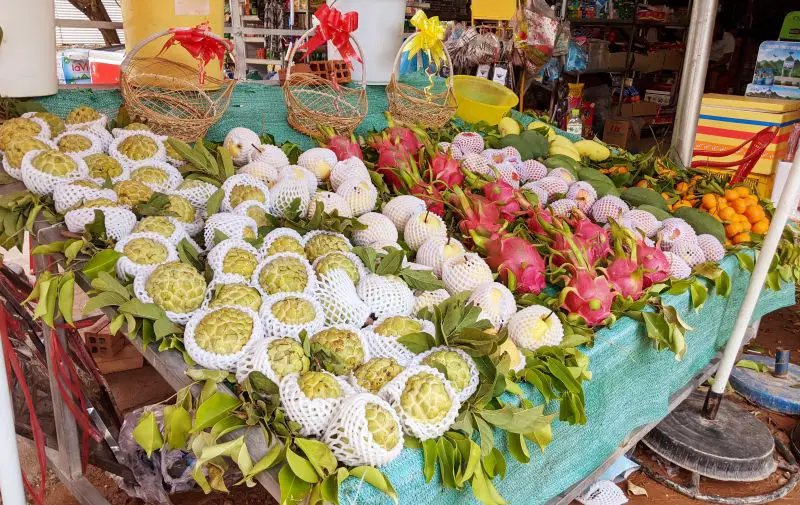
Check out local fruits on display when traveling throughout Vietnam.
1. Durian
Availability: All year round
With the off-green spiky outer shell and the pungent smell, durian (sầu riêng in Vietnamese) is one of the most loved and most hated fruits in Vietnam. It’s considered the “King of Fruit,” and is available in all of Southeast Asia. Inside the fruit has light yellow pieces inside sections of durian.
The texture is similar to a smooth, rich custard. It’s one of the reasons why it’s enjoyed in many desserts such as Vietnamese sweet dessert (chè with chunks of durian), sticky rice (xôi sầu riêng), and cakes with durian cake and cream filling. We had a durian cake from Tous Les Jour and it was fantastic!
If you need souvenir ideas, find durian candy, dried durian, and durian pastry (bánh pía).
How to Buy Durian: Durian is either sold by the whole fruit or already prepared in containers. If you buy the whole fruit, the vendor will weigh it and can cut the fruit and place the pieces in containers for easier transport.
Important Tip: If you decide to purchase durian, make sure that your accommodations or transportation will allow it. There may be a sign that bans strong-smelling fruits such as durian and jackfruit. Hotels will give you a fine if you’re caught with durian!
How to Eat Durian: You can eat durian by itself or in the desserts that we mentioned above.
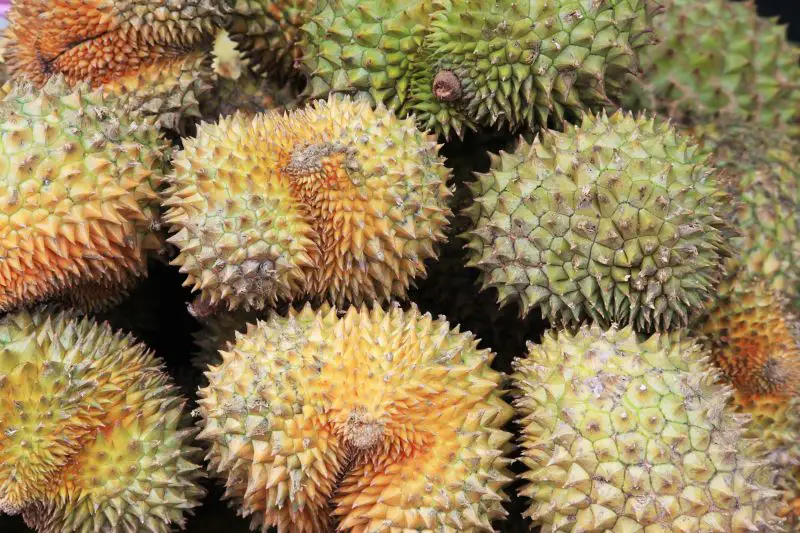
You’ll either love it or dislike eating durian when you’re in Vietnam. Photo credit: spopov via Depositphotos.com
2. Jackfruit
Availability: March-September
Jackfruit (mít) looks similar to durian due to the spiky exterior but it’s not quite the same. Jackfruit tends to be much longer than durian and can weigh as much as 80 pounds (35 kilograms). We can see why it’s considered the heaviest fruit in the world.
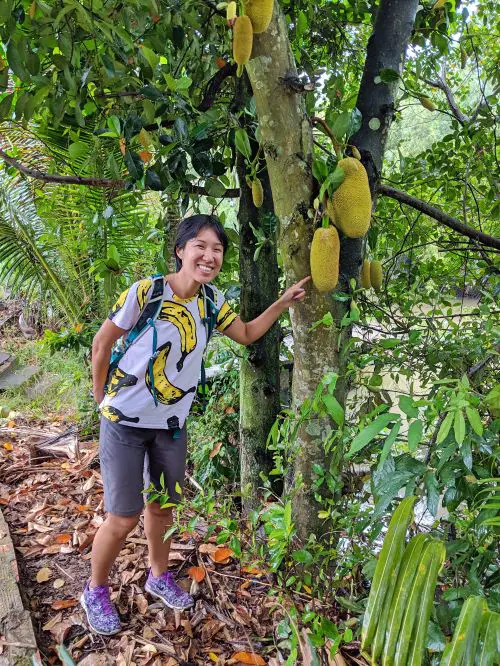
It’s exciting to see a jackfruit tree in Vietnam and see how large the fruit can grow.
Jackfruit is considered one of the “smelly” fruits. While it’s not as pungent as durian, it does have a strong smell and some people are sensitive to the smell. Check with your accommodations and transportation options if having jackfruit is allowed.
Inside the shell has dozens of mustard yellow-colored flesh. It’s best consumed in its natural form. A few pieces go a long way since there is a lot of fiber.
You see jackfruit in Vietnamese desserts (chè) as a side topping. It’s also used as a meat substitute so you’ll see items such as pulled jackfruit sandwiches. (We’ve tried the vegetarian sandwich with jackfruit at Valhalla Grill in Ho Chi Minh City and the filling is on the mushier side).
Important Tip: If you’re staying in Vietnam long-term, you can cook the jackfruit seeds. It’s starchy and has a potato texture.
- All you need to do is place the seeds in a pot of boiling water and cook for 30-45 minutes (depending on the quantity).
- Let the seeds cool down.
- Cut the seeds in halves or quarters.
- Remove the waxy coating and then prepare the seeds in any way you like. We like to saute in olive oil and garlic to make it similar to fried potatoes.
How to Buy Jackfruit: The easiest way is to have the jackfruit already prepared and out of its shell. You can also buy cut portions of the fruit with the shell on. You would need to pick out the fruit. We would not recommend the whole fruit unless you’ll spend a long-term in the country.
How to Eat Jackfruit: We prefer to eat it raw. It has a lot of flavor and a hearty texture. As you eat towards the center of the flesh, there is an edible, slightly rubbery membrane surrounding a large inedible seed (unless you boil the seeds).
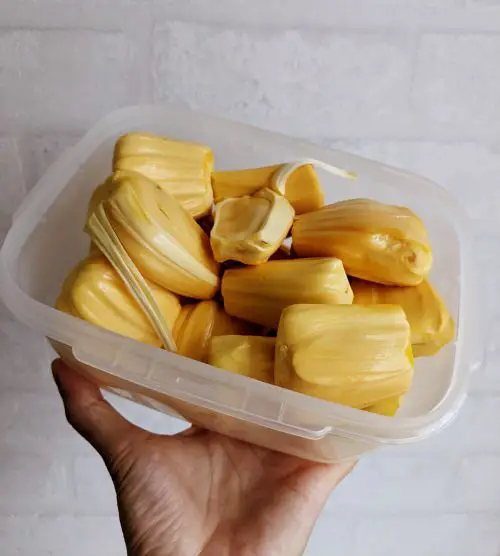
It’s easy to eat jackfruit once they’re already out of the shell.
3. Dragon Fruit
Availability: All year round
Dragon fruit (thanh long) is an odd-shaped fruit as it has bright pink skin with short green spikes or yellow and dark pink skin. Inside is the edible fruit of either white (the most common color), yellow, or dark purple with black seeds, respectively. (You can eat the seeds). The colors are gorgeous, which makes it photogenic in smoothies and acai and fruit bowls.
The fruit has a watery texture, yet it has a hint of sweetness. The experience reminds us of drinking spa water.
Most of the dragon fruit is grown in the Phan Thiet area (close to Mui Ne) in South Vietnam. When flying into Ho Chi Minh City’s airport (Tan Son Nhat International Airport), you may fly over Phan Thiet and see lights glowing in concentrated clusters. The fruit needs 6-8 hours of light so the evening lights help them grow faster.
How to Buy Dragon Fruit: Choose fruits that do not have any wilted skins or spikes or any damages to the pink skin. You can let them sit in the room for 1 day to ripen some more. Otherwise, place them in the fridge if you won’t eat them immediately.
How to Eat Dragon Fruit: There are different ways to eat dragon fruit.
- If you prefer to eat it like orange slices and with the skin on. Cut off the ends of the fruit and cut the whole fruit horizontally. Slice off the spikes. Then, cut the fruit into thin slices and enjoy the edible parts.
- If you prefer to eat cubed. Follow the instructions above and do not cut off the spikes. You can peel off the skin or slice the skin away from the fruit. Then, cut the fruit into cubes.
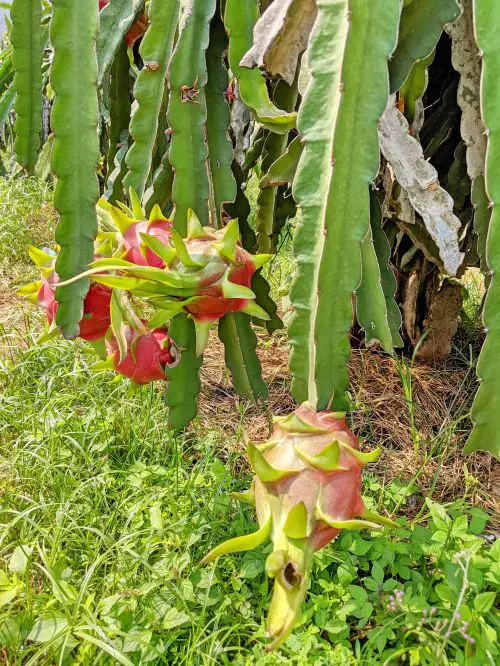
Here is how dragon fruits are grown. It’s quite interesting to see in person.
4. Star Apple
Availability: January-July, November-December
Ever heard of a star apple? It’s also referred to as vú sữa or milk fruit. This circular, purplish-green fruit is unique as the inside texture is milky and slightly sweet. This fruit is grown in the Tien Giang Province in South Vietnam.
How to Buy Star Apple: You can buy either firm or slightly softer fruits. Check for any blemishes and cuts on the skin.
How to Eat Star Apple: To eat the fruit, you’ll need to massage the fruit by rolling it on a counter or table to release the juices. Afterward, slice the fruit in half and then cut thin slices. Eat the white flesh like an orange slice. Watch out for the large seed and the bitter skin. The skin feels sappy so you’ll need to wash your hands a few times afterward.
5. Passion Fruit
Availability: All year round
We love passion fruit (chanh leo) in Vietnam. These are hardy fruits that hold up well in the refrigerator for weeks after ripening.
Passion fruit is an oval shape with dark purple skin. Inside is orange pulp with lots of little seeds clumped together. (It looks like how chia seeds clump together after they’ve been added in liquids). This fruit has tons of Vitamin C and has a slightly sweet and tart flavor.
How to Buy Passion Fruit: The wrinklier the passion fruit, the sweeter it’ll be. Otherwise, the smooth skin fruits are too sour and not edible. You can let the passion fruit ripen at room temperature for a few days before eating.
How to Eat Passion Fruit: Cut the passion fruit in half and use a spoon to scoop out the pulp. Enjoy the fruit! As we mentioned earlier, make sure that the skin is wrinkly. You can also enjoy passion fruit in a passion fruit tea drink (sugar will be added), smoothie bowls, or in a dessert/cake.
6. Guava
Availability: All year round
Guava (ổi) is a staple fruit to consume in Vietnam. This green fruit is similar to eating an apple due to the crunch yet it’s sweeter and juicier. Inside has either white or light pink color flesh.
How to Buy Guava: Pick firm or softer guavas without any blemishes. If you prefer firm guavas, they’re often drier and don’t have any taste. Many Vietnamese eat these unripe guavas by dipping pieces in chili salt. Otherwise, after 1-2 days at room temperature, they’ll get softer and will be sweeter.
How to Eat Guava: Cut it in half and then slice thinly. You can eat the seeds if you have strong teeth and chew very slowly. Otherwise, you can discard them.
Guavas can be consumed naturally or juiced. The fresh guava juice is refreshing on a hot day.
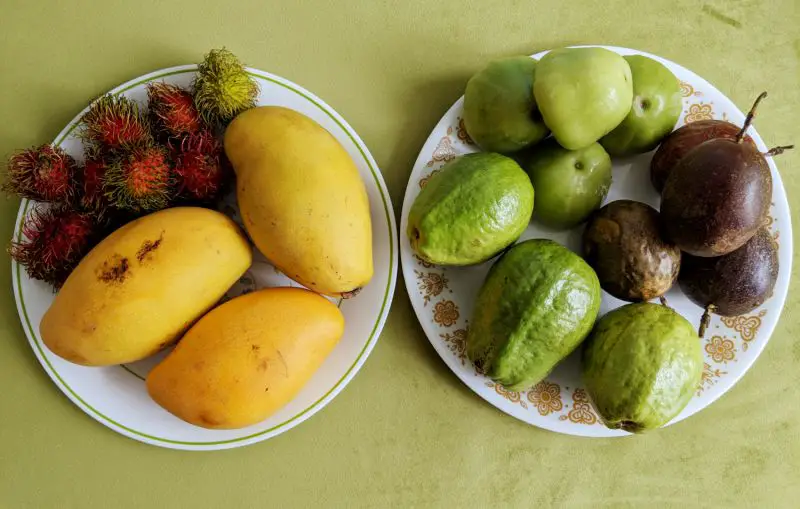
We get these tropical fruits weekly. Guavas are the green fruits on the bottom of the right plate.
7. Mangosteen
Availability: May-August
Mangosteen (măng cụt) is one of our favorite fruits to eat in Vietnam. It’s a seasonal fruit and only available during the summertime from May to August. We’re always excited to see this fruit at the market!
While durian is the “King of Fruits,” mangosteen is considered the “Queen of Fruits.” The story goes that Queen Victoria offered a monetary reward of 100 pounds sterling to anyone who would bring this fruit to her.
This circular fruit has thick purple skin while inside has pearl white bulbs of the mangosteen fruit. The flavor is unique as it’s sweet yet slightly tart and tangy. You must eat the bulbs immediately, otherwise, they’ll turn a dark color from oxidation.
At the bottom of the purple skin, you can count the petals and it’ll associate with the number of pieces inside the fruit.
It’s recommended to eat this fruit by itself to get the purest flavor. We’ve tried mangosteen salad. You can also buy dried mangosteen at the supermarket and bring it back home for souvenirs.
How to Buy Mangosteen: Feel each mangosteen and check if they’re rock hard. If so, then these are not good. Pick mangosteens that have a slight squeeze to the skin so you can break into the fruit easier either with your hands or by using a knife (very carefully). The larger mangosteen tends to have a large seed that isn’t edible.
Note: Large ants like to hang out around the mangosteens’ stem area. Watch out for them when removing the thick skin.
How to Eat Mangosteen: Scrub the mangosteens thoroughly due to the sap and large ants. Afterward, gently squeeze the mangosteen with your hand to break the thick skin. Use your hands or a knife to pull out the bulbs.
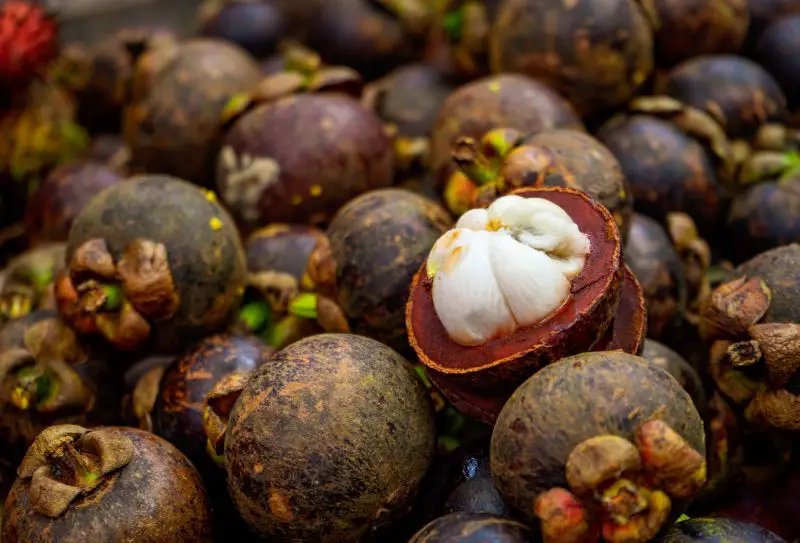
Mangosteens are delicious fruits to enjoy during the summertime. Photo credit: Hannah Judah via Scopio Photos
8. Pomelo
Availability: January-February, August-December
Pomelo (bưởi) is one of our favorite citrus fruits to enjoy in Vietnam. It’s similar to a grapefruit but larger and sweeter. The fruit has green or yellow skin and inside has yellow or pink flesh (with some seeds). We prefer the pink flesh as it’s a pretty color, yet you won’t know what you’ll get unless the vendor shows a sample of the fruit.
How to Buy Pomelo: Choose a heavy pomelo as it’ll be juicier.
How to Eat Pomelo: It requires some work to cut a pomelo as the skin is thick and has a white pith surrounding the pomelo flesh. Do not eat the white pith as it’s bitter. You’ll need to cut off the pith or peel it by hand to get to the fruit.
Fresh pomelo can be eaten by itself or you’ll see it at restaurants as a salad (gỏi bưởi). As a salad, it’s quite delicious with dried shrimp, peanuts, and fish sauce. You’ll also see candied pomelo skin which is given as gifts around the Tet holiday (Vietnamese Lunar New Year).
9. Sugar Apple
Availability: All year round
Can fruit be too sweet? Sugar apple (mãng cầu or sweet sop) is one of the sweetest fruits that we’ve eaten. This light green acorn shape fruit looks similar to soursop, but soursop is much larger and longer.
Inside the sugar apple is white with large inedible black seeds. You’ll get a few dozen seeds. When the fruit is ripe, the smell has a floral fragrance and the texture is soft like custard and a little too sweet. It’s like eating a sugar bomb but it’s natural sugar!
How to Buy Sugar Apple: Buy firm ones that do not have any blemishes on them. Let them sit at room temperature for a couple of days. We do not suggest that you buy any that are already soft unless you plan to eat them immediately.
How to Eat Sugar Apple: The best way to eat the sugar apple is in its natural form. Cut it in half, peel the stem and skin with your hands, and start eating. We haven’t seen it incorporated in any desserts yet.
Tip: You must wait for the fruit to ripen and the skin darks. Don’t let the fruit ripen too long, otherwise, it rots. It’s as finicky as an avocado!
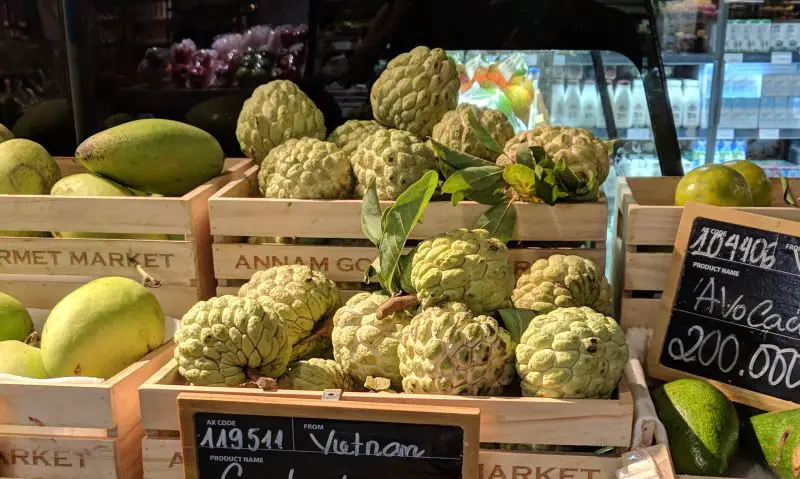
We think sugar apples are the sweetest fruits to eat in Vietnam.
10. Mango
Availability: January-August, October-December
Vietnam grows so many varieties of mangoes (xoài), especially in South Vietnam. At the grocery store, there are mango varieties from Taiwan (which are longer), Australia (more circular), and plenty of Vietnam ones. When driving through South Vietnam’s countryside, you’ll pass by many mango trees on the sidewalks and people’s yards.
We prefer eating the yellow mangoes since they’re sweeter when eaten raw. Yet the green ones are used to make fresh juices and salad.
You’ll see Vietnamese people love eating mango slices with chili salt as a salt. The ripe mangoes are used for smoothies, cakes, and toppings for desserts and smoothie bowls.
How to Buy Mango: Buy firm mangoes whether it’s green or yellow ones. Check for blemishes or bruises as these will make the mango rot faster.
How to Eat Mango: Peel the skin with a peeler or knife. Cut the top part off where the stem is located. Turn the mango sideways and slice the whole fruit in the same direction as the seed. Do the same for the other side of the seed. Afterward, you’ll have two pieces that you can slice into thin pieces or cut into cubes.
11. Lychee
Availability: May-July
Lychee (vải) season is such a treat during the summertime. The majority of lychee is grown in Bac Giang in North Vietnam. When lychees are ready for delivery, many newspaper publications showcase hundreds of motorbike drivers carrying tons of reddish-pink fruit.
Out of the three similar fruits – lychee, rambutan, and longan, lychee is the juiciest and sweetest. There is a small seed inside the fruit that isn’t edible.
Vendors sell lychee with the fruit attached to the stem and bundled together in a bouquet. The bouquets are rather large – a few kilograms, so you can put any uneaten ones in the refrigerator to make them last longer.
If you can’t get lychees fresh, there are canned lychees in simple syrup sold at the grocery stores.
How to Buy Lychee: As long as the skin isn’t cracked or has dark spots, you can grab a bunch at the market. Some vendors may already trim the branches for you.
How to Eat Lychee: Use scissors or pluck off the lychees that you want to eat. Peel the skin using your thumbs and hands and enjoy the fruit. There is an inedible seed inside.
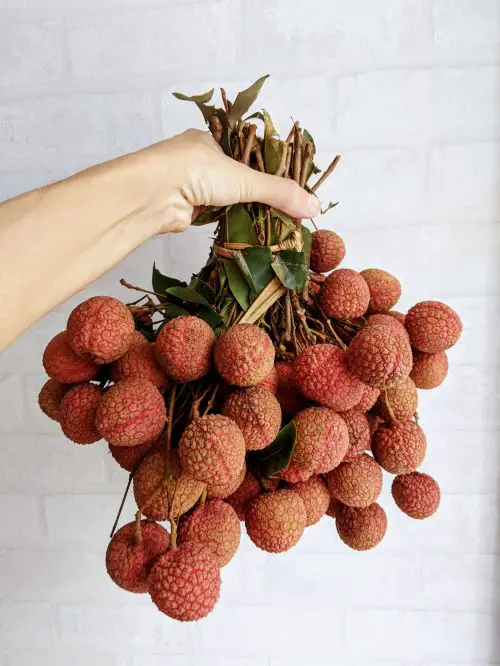
Lychees are one of the yummiest fruits to eat in Vietnam.
12. Rambutan
Availability: May-September
Rambutan (chôm chôm) is a unique-looking fruit as it has a “hairy” appearance. The fruit is pinkish-red and yellow with short spikes all over it. Inside is an off-white oval fruit with a large beige seed inside (not edible). It looks similar to lychee yet the fruit texture is drier compared to lychee.
The flavor is slightly sweet so it pairs nicely in Vietnamese desserts (chè). Otherwise, you can eat it by itself as an afternoon snack.
How to Buy Rambutan: You can find rambutans either in bunches with branches or already plucked off the branches. Choose rambutans that do not have any damaged skins.
How to Eat Rambutan: To enjoy it, use a knife or use your thumbs to puncture the skin and peel it to eat the fruit. Don’t forget to spit out the seeds.
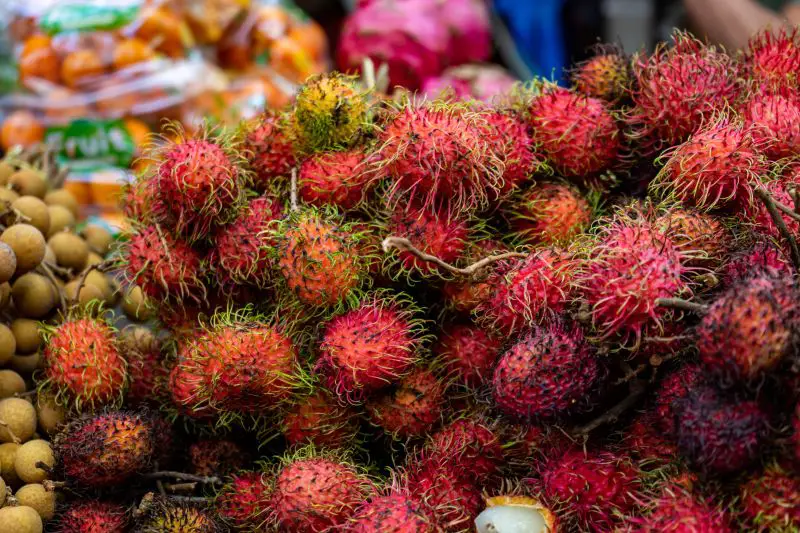
Who wants to try these rambutans? Photo credit: Hannah Judah via Scopio Photos
13. Longan
Availability: All year round
Longan (nhãn lồng) is also referred to as “dragon’s eyes.” You can recognize longan with the small brown circular fruit with the translucent fruit. The fruit texture is similar to lychee and rambutan and is on the sweeter side. There is a black seed inside, which isn’t edible.
Longan can be eaten by itself or in Vietnamese dessert (chè). We normally have it in chè Thái with jellies and tropical fruits. It’s also in lotus seed and longan Vietnamese dessert (chè hạt sen nhãn lồng) which is refreshing to have on a hot day.
How to Buy Longan: Longan is sold as a bouquet with the branches. You can also see them prepared without the branches. Longan is best eaten fresh as after a few days, the skin gets brittle.
How to Eat Longan: Pluck the longan fruit from the branches. Use a knife or your fingers and puncture the skin. Peel the skin and enjoy the fruit.
14. Coconut
Availability: All year round
Who loves drinking coconut water? When visiting Vietnam, it’s best to enjoy coconut (trái dừa in South or quả dừa in North) straight from the fruit.
Many of the coconuts are grown in Ben Tre Province in South Vietnam. The sweetest coconut water to enjoy is dừa xiêm. They’re smaller in size yet the juice is sweet and delicious.
How to Buy Coconut: Wander through a local market and find a place that sells coconuts or fruit juices/smoothies. You can buy the whole coconut and have the vendor chop the top to drink the juice. Or, you can request the vendor to pour the juice into a disposable cup. They may or may not add the coconut meat inside the cup.
How to Eat Coconut: After drinking the coconut juice, it’s time to get the coconut meat. It’s one of the best parts of the fruit. The amount can be a hit or miss. It can be a young coconut with a thin layer of coconut meat or an older one with a tougher and thicker layer. Once we finish the juice, we like to use a spoon to scrape inside the meat.
Coconut is a versatile fruit as you’ll see it in ice cream, desserts, chocolate, salads, iced drinks (the coconut drinks at Cộng Cà Phê coffee chain are so delicious), smoothies, and much more.

Try these young coconuts when traveling through Vietnam.
15. Langsat
Availability: July-October
What is a langsat (bòn bon)? It’s an oval-shaped fruit that is beige and attached to a branch. It tastes like sweet grapefruit but the pieces are bite-size. We’ve only seen this fruit sold at the local market.
How to Buy Langsat: Choose a bunch where the skin isn’t pierced or exposed.
How to Eat Langsat: The fruit has a natural latex on the skin so it’s very sticky when peeling the skin. You must wear disposable gloves, otherwise, your hands will stay sticky for a few hours. Another option is to boil the fruit in hot water for a few minutes so the stickiness comes off.
Afterward, peel the skin and enjoy the fruit. There is a small seed that is edible. Sometimes, the seed is too hard.

Try langsat fruit when you’re in Vietnam.
16. Sapodilla
Availability: January-April, September-December
Sapodilla (hồng xiêm or xa pô chê) is a delicious fruit from Central America. It has brown skin with a golden tan colored inside. There are inedible black seeds inside.
The texture is on the soft, mushier side similar to what you get with a ripe kiwi. Some people say that it has a pear texture.
Once you cut into the fruit, you’ll smell the sweet fragrance. If the fruit isn’t ripe enough, then the fruit is inedible as the fruit is super bitter and stringy.
How to Buy Sapodilla: Look for fruits without any blemishes and cuts in the skin.
How to Eat Sapodilla: Use a knife and cut the sapodilla in half. Either scoop the fruit with a spoon or eat directly. Don’t forget to spit out the seeds as they have a little hook at the end.
In addition, make sure that the sapodilla is ripe. Don’t leave the fruit at room temperature for too long as they can go from ripe to rotten quickly.
Final Thoughts on Vietnam Fruits
Which of these tropical fruits do you want to try? There are so many options to choose from. The prices are affordable so you can easily try a new fruit each day of your Vietnam travels. When you return home, you’ll be shocked at how much these tropical fruits cost at your local grocery store.
Enjoy them while you can while you’re in Vietnam!
Save this post to your Vietnam Pinterest boards.
Pin #1 and Featured photo credit: spopov via Depositphotos.com

